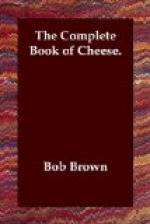The Schachtelkaese is named from the wooden boxes in which it is shipped, while the Schlosskaese shows its class by being called Castle Cheese, probably because it is richer than the others, being made of whole milk.
Money made of cheese
China
In the Chase National Bank collection of moneys of the world there is a specimen of “Cheese money” about which the curator, Farran Zerbee, writes: “A specimen of the so-called ‘cheese money’ of Northern China, 1850-70, now in the Chase Bank collection, came to me personally some thirty years ago from a woman missionary, who had been located in the field where she said a cake form of condensed milk, and referred to as ‘cheese,’ was a medium of exchange among the natives. It, like other commodities, particularly compressed tea, was prized as a trading medium in China, in that it had value as nutriment and was sufficiently appreciated by the population as to be exchangeable for other articles of service.”
Monk’s Head see Tete de Moine.
Monostorer
Transylvania, Rumania
Ewe’s milk.
Monsieur
France
Soft; salted; rich in flavor.
Monsieur Fromage see Fromage de Monsieur Fromage.
Montana
Catalonia
A mountain cheese.
Montasio
Austria and Italy
Usually skimmed goat and cow milk mixed. When finished, the rind is often rubbed with olive oil or blackened with soot. It is eaten both fresh, white and sweet, and aged, when it is yellow, granular and sharp, with a characteristic flavor. Mostly used when three to twelve months old, but kept much longer and grated for seasoning. Widely imitated in America.
Montauban de Bretagne, Fromage de
Brittany, France
A celebrated cheese of Brittany.
Montavoner
Austria
Sour and sometimes sweet milk, made tasty with dried herbs of the Achittea family.
Mont Blanc
France
An Alpine cheese.
Mont Cenis Southeastern France Usually made of all three available milks, cow, goat and sheep; it is semihard and blue-veined like the other Roquefort imitations, Gex and Septmoncel. Primitive methods are still used in the making and sometimes the ripening is done by penicillium introduced in moldy bread. Large rounds, eighteen by six to eight inches, weighing twenty-five pounds.
Mont-des-Cats
French Flanders
Trappist monk-made Port-Salut.
Montdidier
France
A fresh cream.
Mont d’or, le, or Mont Dore
Lyonnais, France
Soft; whole milk; originally goat, now cow; made throughout the Rhone Valley. Fat, golden-yellow and “relished by financiers” according to Victor Meusy. Between Brie and Pont l’Eveque but more delicate than either, though not effeminate. Alpin and Riola are similar. The best is still turned out at Mont d’Or, with runners-up in St. Cyr and St. Didier.




